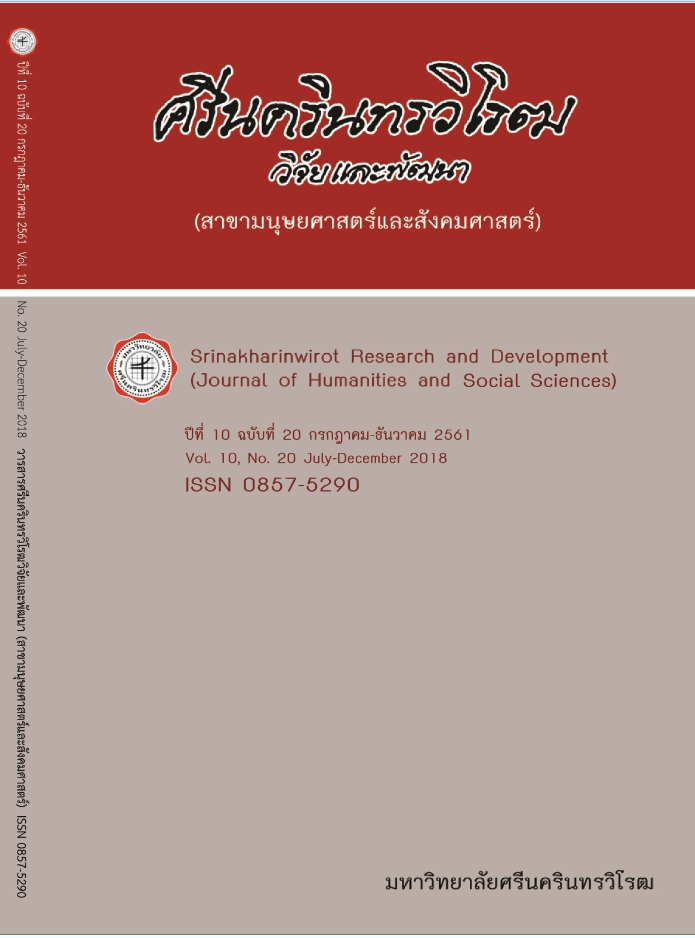การพัฒนาออนโทโลยีนิทานพื้นบ้านอีสานเพื่อการสืบค้นและเข้าถึง THE DEVELOPMENT OF ISAN FOLKTALE ONTOLOGY FOR INFORMATION ACCESS AND RETRIEVAL
Keywords:
ออนโทโลยี, นิทานพื้นบ้านอีสาน, การสังเคราะห์เนื้อหาAbstract
This research focusing on the development of Isan folktale ontology aimed to 1) analyze the knowledge of Isan folktale’s scopes and structures and 2) develop Isan folktale ontology for access and retrieval. The research and development (R&D) approach, including document analysis (analysis of contents, vocabulary and notions found in Isan folktales) was used in conducting the study. The library classification method was used for content synthesis to find the structure of knowledge about Isan folktales. The research instruments were folktale analysis forms. The population of the the study was 77 transformed Isan folktales. The ontological development was based on the facet approach by Prieto-Diaz [1].
The study revealed that scopes and structures of Isan folktales can be categorized into 8 knowledge groups; knowledge about the contents of stories, beliefs, traditions, values, rituals, places, characters, and magical objects. The Isan folktale ontology developing process consists of 1) setting clear purposes for Isan folktale knowledge explanation to be used as a tool for Isan folktale knowledge access; 2) setting a concept model for ontology domain design and development; and 3) developing ontology for Isan folktales, which compiles of 8 main classes (contents of folktales, beliefs, traditions, values, rituals, places, characters, magical objects), 48 subclasses, and 58 object properties. The results of Isan folktale ontology evaluation by experts showed that the classification within the ontology are highly appropriate ( = 3.00). The classification within the ontology can adequately collect knowledge at a very high level ( = 3.00). The names of classes within the ontology are appropriate and can be understood at the highest level ( = 3.33). The classification of classes within the ontology is highly appropriate ( = 3.00). The class’s properties or the features can describe the class itself appropriately at the highest level ( = 3.67). Ontology has a very high level of relationship between classes at a high level ( = 3.00). The relationship names between classes within the ontology are appropriate and can be interpreted at the highest level ( = 3.33). The data type properties and data type details are consistent at a high level ( = 3.00). The ontology is well-designed and suitable for application at the highest level ( = 3.33).
Downloads
References
http://www.cs.uu.nl/docs/vakken/ks/BulidOntologiesRPD-ER2002.pdf
[2] เสาวลักษณ์ อนันตศานต์. (2538). นิทานพื้นบ้านเปรียบเทียบ : Comparative folktales. กรุงเทพฯ: สำนักพิมพ์
มหาวิทยาลัยรามคำแหง.
[3] สิริวรรณ วงษ์ทัต. (2553). วรรณกรรมคำสอนสมัยธนบุรี. วารสารวิชาการมนุษยศาสตร์และสังคมศาสตร์
มหาวิทยาลัยบูรพา. 8(9-10): 79 – 85.
[4] สุรนี แก้วกลม. (2549). รายงานการวิจัย การปริวรรตและวิเคราะห์นิทานพื้นบ้านอีสาน กรณีลำท้าวเสื้อ
เน่า ฉบับวัดอโนดาต จังหวัดอุบลราชธานี. อุบลราชธานี: คณะมนุษยศาสตร์และสังคมศาสตร์
มหาวิทยาลัยราชภัฏอุบลราชธานี.
[5] วิสุทธิ์ เหล็กสมบูรณ์. (2552). นิทานพื้นบ้าน นิทานชาติพันธุ์ : กระบวนการสืบค้นตัวตนเด็กและชุมชน. สืบค้นเมื่อ
3 กรกฎาคม 2558, จาก https://www.gotoknow.org/posts/196410
[6] พิริยะ ผลพิรุฬ. (2556). เศรษฐกิจสร้างสรรค์กับการพัฒนาประเทศไทย. วารสารเศรษฐศาสตร์ปริทรรศน์
สถาบันพัฒนศาสตร์. 7(1): 1 – 69.
[7] สำนักงานคณะกรรมการพัฒนาการเศรษฐกิจและสังคมแห่งชาติ. (2553). สรุปสาระสำคัญแผนพัฒนาเศรษฐกิจ
และสังคมแห่งชาติ ฉบับที่สิบเอ็ด พ.ศ. 2555-2559. กรุงเทพฯ: สำนักงานคณะกรรมการพัฒนาการ
เศรษฐกิจและสังคมแห่งชาติ.
[8] ศิราพร ณ ถลาง. (2558). เรื่องเล่าพื้นบ้านไทยในโลกที่เปลี่ยนแปลง. กรุงเทพฯ: ศูนย์มานุษยวิทยาสิรินทร.
[9] อภิลักษณ์ เกษมผลกูล. (2556). พระวรวงศ์ : วรรณกรรมท้องถิ่นที่แสดงร่องรอยความสัมพันธ์ทาง
ภูมิศาสตร์และวัฒนธรรมระหว่างภาคตะวันออก ภาคกลาง และภาคใต้1 = Phra Voravong:The Geographical
and Cultural Evidence of Relationship between the East, the Central and the South of Thailand. วารสารมนุษยศาสตร์และสังคมศาสตร์. 4(2): 103 – 132.
[10] สุกัญญา สุจฉายา. (2557). วรรณคดีไทย. กรุงเทพฯ: สำนักพิมพ์แห่งจุฬาลงกรณ์มหาวิทยาลัย.
[11] วิเชียร เกษประทุม. (2542). นิทานพื้นบ้าน. กรุงเทพฯ: พัฒนาศึกษา.
[12] กิ่งแก้ว อัตถากร. (2514). วรรณกรรมจากบ้าน. ใน งานทำบุญอายุครบ 5 รอบ ของ ม.ร.ว.พรรณเรือง เกษมสันต์
อัตถากร, 2 เมษายน 2514, หน้า 10.
[13] กุหลาบ มัลลิกะมาส. (2518). คติชาวบ้าน. กรุงเทพฯ: ชวนพิมพ์สำราญราษฎร์.
[14] ประคอง นิมมานเหมินทร์. (2551). นิทานพื้นบ้านศึกษา. กรุงเทพฯ: โครงการเผยแพร่ผลงานวิชาการ
คณะอักษรศาสตร์ จุฬาลงกรณ์มหาวิทยาลัย.
[15] Thompson, S. (1916). The Texas Folklore Society Collection. Retrieved February 25, 2017, from
https://texashistory.unt.edu/explore/collections/TFSP/
[16] กองโบราณคดี. (2531). ตำนานและนิทานพื้นบ้านอีสาน. กรุงเทพฯ: กองโบราณคดี กรมศิลปากร.
[17] วิจิตรา ขอนยาง. (2532). การศึกษาประเพณีจากวรรณกรรมนิทานพื้นบ้านอีสาน. ปริญญาศิลปศาสตร
มหาบัณฑิต มหาวิทยาลัยศรีนครินทรวิโรฒ มหาสารคาม.
[18] อนัญญา ปานจีน. (2553). การศึกษาคติความเชื่อเรื่องพญานาคในพื้นที่อีสานตอนบน เพื่อเสนอแนวทาง สู่การ
ออกแบบสถาปัตยกรรมภายในพิพิธภัณฑ์นาคา. กรุงเทพฯ: ศิลปศาสตรมหาบัณฑิต สาขาวิชาการ
ออกแบบภายในภาควิชาออกแบบตกแต่งภายใน บัณฑิตวิทยาลัย มหาวิทยาลัยศิลปากร.
[19] วนิดา อ่อนละมัย; และ สุดสันต์ สุทธิพิศาล. (2558). การปรับใช้วรรณกรรมสินไซโดยชุมชนเพื่อสนับสนุน การท่องเที่ยวเชิงวัฒนธรรม = Adaptive Use of “Sin – Sai” Literature for Supporting CulturalTourism,
วารสารวิชาการการท่องเที่ยวไทยนานาชาติ. 11(2): 64 – 77.
[20] พิสุทธา จันทร์สมบัติ. (2553). การพัฒนาหนังสือิเล็กทรอนิกส์ นิทานพื้นบ้าน ชั้นมัธยมศึกษาปีที่ 1.
มหาสารคาม: มหาวิทยาลัยมหาสารคาม.
[21] ขวัญชนก นัยจรัญ. (2557). การวิเคราะห์ภาพสะท้อนค่านิยมของไทยจากนิทานพื้นบ้าน = An Analysis of
Popularity reflection in Thai from Folktales. กรุงเทพฯ: มหาวิทยาลัยเทคโนโลยีราชมงคลสุวรรณภูมิ.
[22] อมฤต หมวดทอง; สุพิชชา โตวิวิชญ์; และ อรศิริ ปาณินท์. (2559). ภูมินาม การให้ความหมายของพื้นที่ :
กรณีศึกษา ชุมชนรอบหนองหาน กุมภวาปี จังหวัดอุดรธานีเกี่ยวกับตำนานผาแดง – นางไอ่ = Toponym
and Its Definition Through Pha Dang Nang Ai Tale : A Case Study of Communities Around Nong Harn
Lake, Udon Thani Province. ใน การประชุมวิชาการทางสถาปัตยกรรม “สรรค์สาระสถาปัตยกรรมพื้นถิ่นและสภาพแวดล้อมทางวัฒนธรรม ประจำปี 2559”. ขอนแก่น: คณะสถาปัตยกรรมศาสตร์ มหาวิทยาลัยขอนแก่น.
[23] รังสิมา กุลพัฒน์. (2554). ตามรอยปาจิต – อรพิมบนเส้นทางสายตำนานไทย – ลาว – เขมร. สืบค้นเมื่อ 25
กุมภาพันธ์ 2560, จาก http://lek-prapai.org/home/view.php?
[24] อธิชัย อรรคอุดม. (2553). การพัฒนาแนวคิดและมาตรวัดต้นแบบตราสินค้าเพื่อประยุกต์ใช้เชิงการสื่อสาร
การตลาด. ปรัชญาดุษฎีบัณฑิต คณะนิเทศศาสตร์ จุฬาลงกรณ์มหาวิทยาลัย.
[25] พาเที่ยวทั่วไทยตามรอย 8 ตำนาน-ความเชื่อ. (2557). สืบค้นเมื่อ 25 กุมภาพันธ์ 2560, จาก
http://www.painaidii.com/diary/diary-detail/001436/lang/th/
[26] นริศรา ศรีสุพล. (2558, กรกฎาคม – ธันวาคม). การสร้างสรรค์นาฏศิลป์พื้นเมืองจากวรรณกรรมเรื่องอุสา บารส
ในบริบทวัฒนธรรม. วารสารสถาบันวัฒนธรรมและศิลปะ. 17(1): 76-83.
[27] อุทยานประวัติศาสตร์ภูพระบาท. (ม.ป.ป.). นิทานพื้นบ้านเรื่อง “อุสา-บารส”. สืบค้นเมื่อ 25 กุมภาพันธ์ 2560, จากhttp://www.finearts.go.th/phuphrabathistoricalpark/index.php/parameters/km/item/
Downloads
Published
How to Cite
Issue
Section
License
Srinakharinwirot Research and Development Journal of Humanities and Social Sciences is licensed Under a Creative Commons Attribution-NonCommercial-NoDerivs 4.0 International (CC-BY-NC-ND 4.0) License, Unless Otherwise Stated. Please Read Journal Policies Page for More Information on Open Access, Copyright and Permissions.



